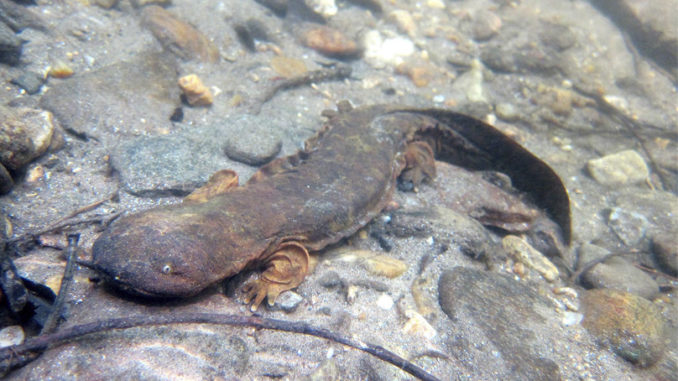
Hellbenders are also known as water dogs
With fall fishing right around the corner, the N.C. Wildlife Resources Commission is asking the public, particularly anglers, to report any sightings of hellbenders (water dogs) to the agency.
Reported sightings are an important part of a long-term inventory and monitoring project for hellbenders. Agency staff, along with partners began this monitoring process in 2007. Hellbenders are gigantic, aquatic salamanders. They average 16 to 17 inches in length. Agency biologists want to learn more about where they are located and how their populations are faring.
In North Carolina, hellbenders are found only in fast-moving, clean mountain streams in the western part of the state. Hellbenders, also called “snot otters” and “Alleghany alligators,” were once common. But they have disappeared throughout much of their habitat. Declining water quality and habitat degradation contribute to their downfall. And to a lesser degree, persecution from anglers who mistakenly think that hellbenders decrease trout populations.
They may occasionally go after a trout on a line or stringer, looking for an easy meal. But hellbenders eat mainly crayfish according to Wildlife Diversity Biologist Lori Williams. Williams pioneered the Commission hellbender project. “They may also eat unsuspecting minnows and scavenge for dead fish, discarded bait or other dead animals. However, fish can be bigger predators of young or larval hellbenders than hellbenders of fish.”
Hellbenders are not harmful to humans
Contrary to popular belief, hellbenders are not poisonous, venomous, toxic, or harmful to humans. However, they may try to bite as a defensive reaction if someone tries to pick them up. Leaving them alone is not only good for hellbenders, but it is also the law. Hellbenders are listed as a species of special concern in North Carolina. Because of this listing, it is illegal to take, possess, transport, or sell a hellbender or to attempt to do so. A violation is a Class 1 misdemeanor, which can result in a fine and up to 120 days in jail.
Williams also cautions people to refrain from moving rocks in mountain streams to build dams, rock stacks (cairns), or tube chutes as these rocks provide shelter for hellbenders, as well as other species of fish, salamanders, and insects.
Anyone who finds a hellbender is asked to leave it alone but to note the location (physical location or GPS coordinates) and take a photo, if possible, and email that information to Williams at lori.williams@ncwildlife.org. If anglers happen to catch one on hook and line, they should carefully remove the hook if it is safe to do so without harming the animal or cut the line as close as possible and return it back to the water. People also can call the Commission’s Wildlife Interaction Helpline (866) 318-2401 and provide details of the observation.
Learn more by visiting the Commission’s hellbender webpage.
________________
Have you seen a tegu lizard? Unlike hellbenders, tegu lizards are invasive and harmful to native wildlife populations. Click here to read more.




Be the first to comment